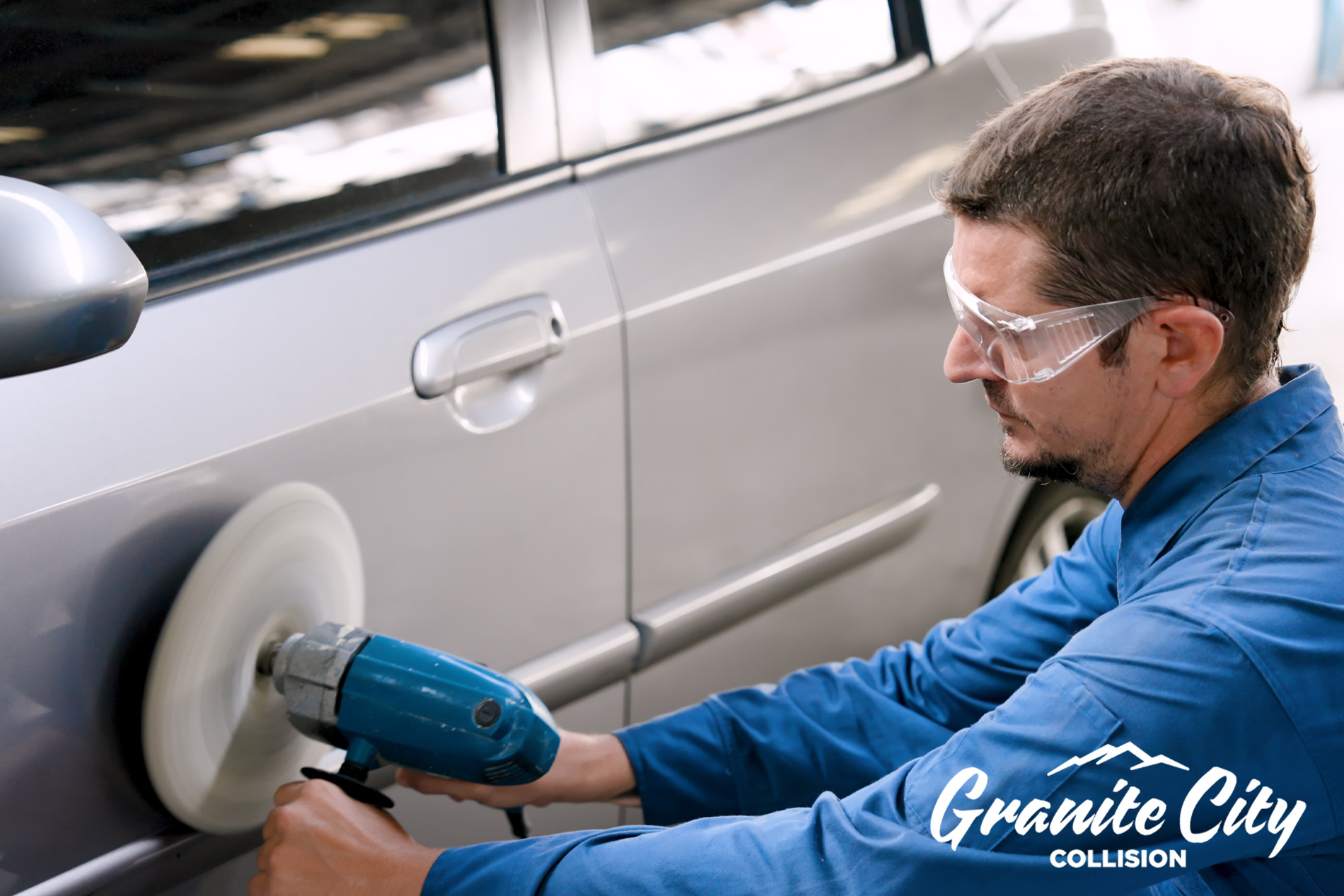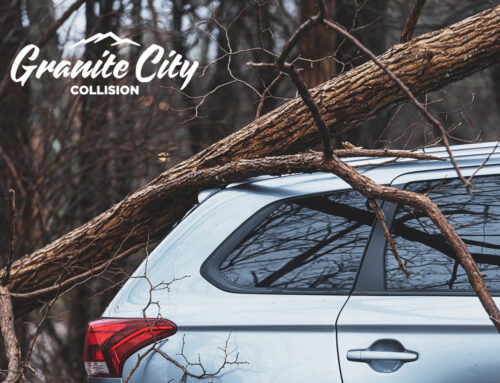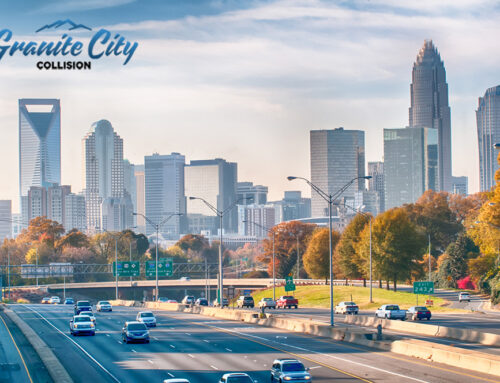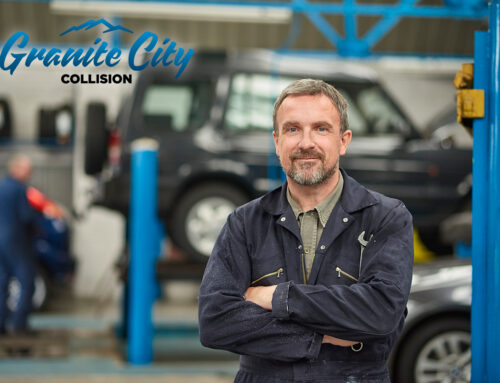Staying informed ensures optimal care for your vehicle in the dynamic realm of auto body repair. As technology advances, understanding calibration and achieving flawless paint jobs becomes paramount. This guide explores trends and essential information to empower your collision repair journey.
We discuss calibration’s significance, unveil paint job secrets, and clarify OEM versus aftermarket parts. We also navigate ceramic coatings, revealing their benefits. Together, we demystify body shop procedures, equipping you with the knowledge to make informed decisions for your vehicle’s restoration. Trust Granite City Collision to support you every step so your car gets top-notch care for years!
The Calibration Trend
In an era when technology evolves faster than ever, the auto body industry finds itself at the forefront of innovation and adaptation. From the integration of sophisticated electronics to the rise of self-driving vehicles, the landscape of auto repairs is undergoing a profound transformation. Understanding current and future trends is essential for both professionals and car owners.
One of the most significant shifts in the auto body industry is the increasing reliance on electronics and sensors. Modern vehicles have many sensors to enhance safety, improve performance, and enable advanced driver assistance systems (ADAS). These sensors (e.g., radar, lidar, cameras, ultrasonic devices) play a crucial role in how cars perceive and interact with their surroundings.
That said, the proliferation of sensors presents a unique challenge for auto repair shops: recalibration. Accurately calibrating these advanced systems is paramount for optimal performance and safety. Even a minor adjustment or repair to the vehicle’s body can disrupt sensor alignment, potentially compromising functionality.
In the short term, recalibrating advanced sensor systems poses a considerable challenge for technicians. Specialized equipment and expertise are required to align sensors precisely to the manufacturer’s specifications. Failure to recalibrate correctly can lead to false alarms, decreased accuracy, or even complete system failure — all of which put drivers at risk.
The industry is poised to embrace more self-calibrating solutions to streamline recalibration. Manufacturers are developing innovative technologies that enable sensors to recalibrate autonomously based on real-time data and feedback. Plus, there’s a growing emphasis on camera-based systems, which are inherently more flexible and less prone to misalignment than traditional sensors.
Keep these tips in mind when it comes calibration work:
- Stay informed. Familiarize yourself with the sensor systems in your vehicle and their calibration requirements.
- Monitor warning signs. Pay attention to warning lights or erratic behavior from ADAS features, as these may indicate the need for recalibration.
- Choose certified technicians. Opt for technicians trained and certified in sensor recalibration when seeking auto body repairs.
- Regular maintenance. Schedule routine maintenance checks to ensure sensor systems remain calibrated adequately over time.
The auto body industry is undergoing a significant transformation driven by electronics and sensor technology advancements. While recalibrating advanced systems presents challenges in the short term, the future promises more streamlined and autonomous solutions. Remaining informed and proactive will equip you to navigate these changes effectively while keeping your modern vehicle safe and reliable.
Achieving Flawless Paint
At Granite City Collision, we understand that painting car bumpers is complex and meticulous. Whether you’ve been in a minor fender bender or want to refresh your vehicle’s look, our team is committed to providing top-quality bumper painting services. Let’s examine the steps in painting car bumpers and some of our challenges:
Prep Work
The first step in painting car bumpers is preparation. This involves thorough cleaning and sanding to remove dirt, debris, or old paint. Once the bumper is clean and smooth, we apply a primer to ensure proper paint adhesion. The primer also helps fill imperfections and provides a smooth surface for the paint to adhere to. After the primer has dried, we apply a sealer to enhance adhesion further and provide a base for the paint. The sealer also helps improve the paint job’s overall durability and longevity.
Painting Like a Pro
When painting car bumpers, we use high-quality automotive paint that matches your vehicle’s color. Our experienced technicians carefully apply multiple coats of paint to achieve even coverage and a flawless finish. Depending on the color and type of paint used, an additional clear coat may be applied to protect the paint and provide a glossy finish.
Matching Colors
One of the challenges we face when painting car bumpers is ensuring a seamless match to the rest of the vehicle’s paint. Different car brands and models may have varying paint formulations, and getting a perfect color match can be tricky. But our skilled technicians harness advanced color-matching technology and years of experience for a precise match every time.
Some car bumpers may have complex shapes or textures requiring special attention during painting. Our team has the expertise and specialized tools to handle even the most intricate bumper designs so you get a flawless finish that seamlessly blends with the rest of your vehicle.
We take pride in our attention to detail and commitment to customer satisfaction. When you trust us with your bumper painting needs, rest assured your vehicle will receive the highest care and craftsmanship. Contact us today to learn more about our bumper painting services and schedule an appointment!
Parts: Certified OEM vs. Aftermarket
When it comes to repairing your vehicle after an accident, the choice of replacement parts can significantly impact its performance, safety, and longevity. Granite City Collision understands the critical role that car replacement parts play in restoring your vehicle to its pre-accident condition. Knowing the key differences between OEM (Original Equipment Manufacturer) and aftermarket parts will help you make informed decisions about your car repairs.
OEM parts are made by the same manufacturer that produced the original parts for your vehicle. These parts are designed to meet the exact specifications and quality standards set by the automobile manufacturer. As a result, OEM parts offer a precise fit and are guaranteed to perform as intended. They also come with a warranty for added peace of mind.
In contrast, aftermarket parts are produced by third-party manufacturers and may vary in quality and compatibility. While aftermarket parts are often more affordable than OEM parts, they may not meet the same stringent quality standards. Hence, there’s a higher risk of fitment issues and compromised performance with aftermarket parts.
Consider these four factors when choosing between OEM and aftermarket parts for your car repairs:
- Quality: OEM parts are manufactured to the highest quality standards and are guaranteed to meet or exceed the performance of the original parts. Aftermarket parts may vary in quality, and there is a risk of receiving substandard or poorly fitting parts.
- Fitment: OEM parts are designed to fit your vehicle perfectly, which promotes a seamless repair process and optimal performance. Aftermarket parts may require modifications or adjustments to achieve the same level of fit and finish.
- Warranty: OEM parts typically come with a warranty from the manufacturer, providing more protection for car owners. Aftermarket parts may not come with the same level of warranty coverage, leaving you vulnerable to potential issues down the line.
- Resale value: Using OEM parts for your car repairs can help preserve the resale value of your vehicle, as they maintain the car’s original specifications and integrity. Aftermarket parts may detract from the resale value if perceived as inferior or incompatible.
We recommend using OEM parts for car repairs to guarantee the highest quality, performance, and safety standards. Our experienced technicians are trained to work with OEM parts and will restore your automobile to its pre-accident condition.
Insurance Riders
Consider adding an insurance rider for OEM parts coverage when working with your insurance provider. This rider ensures your policy explicitly covers the cost of OEM parts in the event of an accident, which minimizes out-of-pocket expenses while guaranteeing high-quality components are used for your vehicle’s repairs. Consulting with your insurance agent about adding this rider can provide financial protection and peace of mind throughout the repair process.
Understanding Ceramic Coatings
Ceramic coatings have emerged as a game-changer in automotive aesthetics and protection. These coatings offer unprecedented shine and durability for vehicle exteriors but pose unique challenges for auto body shops. Let’s explore the pros and cons of ceramic coatings and how they impact the repair process.
Pros and Cons of Ceramic Coatings
Ceramic coatings, often comprised of silicon dioxide (SiO2) or titanium dioxide (TiO2), create a semi-permanent bond with the vehicle’s paint. This bond enhances gloss and repels contaminants, offering exceptional durability against UV damage, environmental pollutants, and minor scratches. These coatings also provide low-maintenance, hydrophobic properties. That said, their strong bond can pose challenges during repair, leading to adhesion issues and compromised repair quality.
Implications for Auto Body Shops
For auto body shops, navigating the world of ceramic coatings requires careful consideration and expertise. Technicians must take extra precautions to remove the coating entirely before conducting any paint or bodywork. This often involves specialized techniques and products that facilitate thorough removal without damaging the underlying paint.
Insider Tips for Ceramic Coating
As you can see, ceramic coatings come with benefits and drawbacks, but one thing is clear: a professional shop like Granite City Collision should be involved! Let’s look at some professional-grade insights for dealing with ceramic coatings:
Remember that timing is crucial.
When it comes to applying ceramic coatings to your vehicle. It’s best to schedule this process after completing any necessary auto body repairs. Doing so ensures seamless coating integration with the repaired surfaces to capture a flawless finish that enhances both protection and aesthetics.
Leave it to seasoned professionals.
Experienced technicians have the expertise and finesse required for optimal results. Their proficiency means the coating will be applied evenly and effectively, which will maximize its protective capabilities and enhance the overall appearance of your vehicle.
Follow the recommended maintenance procedures.
Regular upkeep routines are essential for preserving the coating’s integrity and safeguarding your vehicle’s finish against environmental elements and daily wear and tear. Following these guidelines diligently will extend your ceramic coating’s lifespan while upholding your car’s pristine look for years to come.
The Bottom Line
Being an informed consumer is essential when navigating the intricacies of auto body repair. You can make educated decisions regarding your vehicle’s maintenance and restoration by staying current on the latest trends and understanding key concepts like calibration, paint jobs, parts selection, and ceramic coatings.
Granite City Collision is here to support you every step of the way, with expert guidance and unparalleled service to confirm your vehicle receives the attention it deserves. With this knowledge, you can confidently approach your collision repair needs, knowing you’re equipped to get optimal results and keep your vehicle looking and performing its best.






